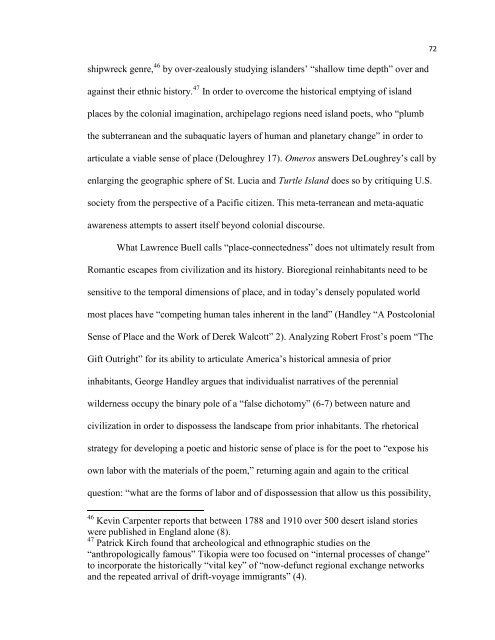RE-INHABITING THE ISLANDS - The University of North Carolina at ...
RE-INHABITING THE ISLANDS - The University of North Carolina at ...
RE-INHABITING THE ISLANDS - The University of North Carolina at ...
Create successful ePaper yourself
Turn your PDF publications into a flip-book with our unique Google optimized e-Paper software.
shipwreck genre, 46 by over-zealously studying islanders‘ ―shallow time depth‖ over and<br />
against their ethnic history. 47 In order to overcome the historical emptying <strong>of</strong> island<br />
places by the colonial imagin<strong>at</strong>ion, archipelago regions need island poets, who ―plumb<br />
the subterranean and the subaqu<strong>at</strong>ic layers <strong>of</strong> human and planetary change‖ in order to<br />
articul<strong>at</strong>e a viable sense <strong>of</strong> place (Deloughrey 17). Omeros answers DeLoughrey‘s call by<br />
enlarging the geographic sphere <strong>of</strong> St. Lucia and Turtle Island does so by critiquing U.S.<br />
society from the perspective <strong>of</strong> a Pacific citizen. This meta-terranean and meta-aqu<strong>at</strong>ic<br />
awareness <strong>at</strong>tempts to assert itself beyond colonial discourse.<br />
Wh<strong>at</strong> Lawrence Buell calls ―place-connectedness‖ does not ultim<strong>at</strong>ely result from<br />
Romantic escapes from civiliz<strong>at</strong>ion and its history. Bioregional reinhabitants need to be<br />
sensitive to the temporal dimensions <strong>of</strong> place, and in today‘s densely popul<strong>at</strong>ed world<br />
most places have ―competing human tales inherent in the land‖ (Handley ―A Postcolonial<br />
Sense <strong>of</strong> Place and the Work <strong>of</strong> Derek Walcott‖ 2). Analyzing Robert Frost‘s poem ―<strong>The</strong><br />
Gift Outright‖ for its ability to articul<strong>at</strong>e America‘s historical amnesia <strong>of</strong> prior<br />
inhabitants, George Handley argues th<strong>at</strong> individualist narr<strong>at</strong>ives <strong>of</strong> the perennial<br />
wilderness occupy the binary pole <strong>of</strong> a ―false dichotomy‖ (6-7) between n<strong>at</strong>ure and<br />
civiliz<strong>at</strong>ion in order to dispossess the landscape from prior inhabitants. <strong>The</strong> rhetorical<br />
str<strong>at</strong>egy for developing a poetic and historic sense <strong>of</strong> place is for the poet to ―expose his<br />
own labor with the m<strong>at</strong>erials <strong>of</strong> the poem,‖ returning again and again to the critical<br />
question: ―wh<strong>at</strong> are the forms <strong>of</strong> labor and <strong>of</strong> dispossession th<strong>at</strong> allow us this possibility,<br />
72<br />
46 Kevin Carpenter reports th<strong>at</strong> between 1788 and 1910 over 500 desert island stories<br />
were published in England alone (8).<br />
47 P<strong>at</strong>rick Kirch found th<strong>at</strong> archeological and ethnographic studies on the<br />
―anthropologically famous‖ Tikopia were too focused on ―internal processes <strong>of</strong> change‖<br />
to incorpor<strong>at</strong>e the historically ―vital key‖ <strong>of</strong> ―now-defunct regional exchange networks<br />
and the repe<strong>at</strong>ed arrival <strong>of</strong> drift-voyage immigrants‖ (4).
















